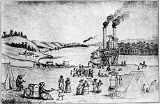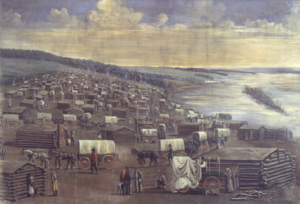
Winter Quarters, Nebraska
Encyclopedia

Winter Quarters was an encampment formed by approximately 2,500 members of the Church of Jesus Christ of Latter-day Saints as they waited during the winter of 1846–47 for better conditions for their trek westward. It followed a preliminary tent settlement some 3½ miles west at Cutler's Park
Cutler's Park
Cutler's Park was briefly the headquarter camp of The Church of Jesus Christ of Latter-day Saints established by 2500 members as they were making their way westward to the Rocky Mountains...
. The Mormons built more than 800 cabins at the Winter Quarters settlement. Located in present-day North Omaha overlooking the Missouri River, the settlement remained populated until 1848.
History
Wintering Saints had left their homes in Nauvoo, IllinoisNauvoo, Illinois
Nauvoo is a small city in Hancock County, Illinois, United States. Although the population was just 1,063 at the 2000 census, and despite being difficult to reach due to its location in a remote corner of Illinois, Nauvoo attracts large numbers of visitors for its historic importance and its...
on relatively short notice and brought limited useful supplies. An influential non-Mormon Thomas L. Kane
Thomas L. Kane
Thomas Leiper Kane was an American attorney, abolitionist, and military officer who was influential in the western migration of the Latter-day Saint movement and served as a Union Army colonel and general of volunteers in the American Civil War...
, seeking to convince the LDS leadership to establish a volunteer military group (later known as the Mormon Battalion
Mormon Battalion
The Mormon Battalion was the only religiously based unit in United States military history, and it served from July 1846 to July 1847 during the Mexican-American War. The battalion was a volunteer unit of between 534 and 559 Latter-day Saints men led by Mormon company officers, commanded by regular...
), received permission from the U.S. federal government for the group to encamp in Omaha Tribe lands, including the site of Cutler's Park. Conditions at the settlement remained primitive the first month, with pioneers living in tents while the men put up hay, found water and managed the cattle.
Due to arguments among the Oto and Omaha tribes over use of the land, the Mormons moved their camp three miles east to a site overlooking the Missouri River. There they built cabins and sod houses for the winter. One group of cabins became known as Kimball Row. It consisted of thirteen adjacent cabins, with the homes of church leaders Heber C. Kimball
Heber C. Kimball
Heber Chase Kimball was a leader in the early Latter Day Saint movement. He served as one of the original twelve apostles in the early Latter Day Saint church, and as first counselor to Brigham Young in the First Presidency of The Church of Jesus Christ of Latter-day Saints from 1847 until his...
and Newel K. Whitney
Newel K. Whitney
Newel Kimball Whitney was a prominent leader of The Church of Jesus Christ of Latter-day Saints and an American businessman. He served as Bishop of Kirtland, Ohio, Far West, Missouri, and Nauvoo, Illinois. He also served as the second Presiding Bishop of the Church from 1847 until his death...
at either end. The Latter-day Saints actively traded with American Indian and trading settlements in northern Missouri
Missouri
Missouri is a US state located in the Midwestern United States, bordered by Iowa, Illinois, Kentucky, Tennessee, Arkansas, Oklahoma, Kansas and Nebraska. With a 2010 population of 5,988,927, Missouri is the 18th most populous state in the nation and the fifth most populous in the Midwest. It...
and Iowa
Iowa
Iowa is a state located in the Midwestern United States, an area often referred to as the "American Heartland". It derives its name from the Ioway people, one of the many American Indian tribes that occupied the state at the time of European exploration. Iowa was a part of the French colony of New...
, exchanging household goods and small amounts of cash for foodstuffs, such as hogs, grain and vegetables, and supplies for the emigration effort. Young Mormon men also produced handcrafted items such as willow baskets and washboards for sale. Church funds also allowed the community to build a much needed water-powered gristmill
Gristmill
The terms gristmill or grist mill can refer either to a building in which grain is ground into flour, or to the grinding mechanism itself.- Early history :...
.
Even with trade, diet in the camp was mainly corn bread, salt bacon and a little milk, with occasional fresh game or domestic meat. Scurvy
Scurvy
Scurvy is a disease resulting from a deficiency of vitamin C, which is required for the synthesis of collagen in humans. The chemical name for vitamin C, ascorbic acid, is derived from the Latin name of scurvy, scorbutus, which also provides the adjective scorbutic...
, known as "blackleg" during this period, became a major problem. Missouri potatoes and horseradish found at old Fort Atkinson helped ease the level of disease, but all residents lacked fresh vegetables in their diet. Tuberculosis
Tuberculosis
Tuberculosis, MTB, or TB is a common, and in many cases lethal, infectious disease caused by various strains of mycobacteria, usually Mycobacterium tuberculosis. Tuberculosis usually attacks the lungs but can also affect other parts of the body...
(known as consumption), malaria
Malaria
Malaria is a mosquito-borne infectious disease of humans and other animals caused by eukaryotic protists of the genus Plasmodium. The disease results from the multiplication of Plasmodium parasites within red blood cells, causing symptoms that typically include fever and headache, in severe cases...
, and unidentified fevers and chills also plagued the temporary settlement. Church member Louisa Barnes Pratt recalled in her memoirs:
- "I hired a man to build me a sod cave. He took turf from the earth, laid it up, covered it with willow brush and sods. Built a chimney of the same. . . . I paid a five dollar gold piece for building my sod house, 10 x 12. . . . A long cold rain storm brought more severely again the chills and fever. These with scurvy made me helpless indeed! . . . Many of my friends sickened and died in that place, when I was not able to leave my room, could not go to their bedside to administer comfort to them in the last trying hours, not even to bid them farewell. Neither could I go to see their remains carried to their final resting place where it was thought I would shortly have to be conveyed."
Church records for the first summer do not contain information on disease victims; however, later records indicate that, from mid-September 1846 to May 1848, disease caused the deaths of 359 residents.
Brigham Young
Brigham Young
Brigham Young was an American leader in the Latter Day Saint movement and a settler of the Western United States. He was the President of The Church of Jesus Christ of Latter-day Saints from 1847 until his death in 1877, he founded Salt Lake City, and he served as the first governor of the Utah...
supervised construction of the Florence Mill
Florence Mill (Omaha, Nebraska)
Florence Mill, also known as the Weber Mill, is located at 9102 North 30th Street near the 30th Street exit on Interstate 680 in the Florence community in North Omaha, Nebraska. It was built in 1846 and operated into the 1960s. It was listed on the National Register of Historic Places as Weber Mill...
. Today it is reportedly the only surviving building in the area to have been built by Mormons. The settlers needed a mill to grind corn, wheat, and rye to create cornmeal and flour products. Constructed next to Turkey Creek, later called Mill Creek, which flowed into the Missouri River, the original structure was started in the fall of 1846. it was completed by spring of 1847 at the cost of $3000. Brigham Young sold this mill to John Neff, who left it when he also moved to Salt Lake City. Later settlers renovated and used the mill for years. Evidence of the original construction techniques has been found in the surviving Florence Mill.
Today, the area that was once Winter Quarters is part of the community of Florence
Florence, Nebraska
Florence is a neighborhood in Omaha, Nebraska on the city's north end and originally one of the oldest cities in Nebraska. It was incorporated by the Nebraska Territorial Legislature on March 10, 1857. The site of Winter Quarters for Mormon migrants traveling west, it has the oldest cemetery for...
, located in North Omaha. The pioneer community is remembered with several attractions, including the Mormon Pioneer Cemetery
Mormon Pioneer Cemetery
The Mormon Pioneer Cemetery is located at 3301 State Street in present-day Florence at the north end of Omaha, Nebraska. The Cemetery is the burial site of hundreds of Mormon pioneers who lived in Winter Quarters, a temporary settlement that lasted from 1846 to 1848 as the settlers moved to Salt...
, Cutler's Park
Cutler's Park
Cutler's Park was briefly the headquarter camp of The Church of Jesus Christ of Latter-day Saints established by 2500 members as they were making their way westward to the Rocky Mountains...
, and the Mormon Pioneer Memorial Bridge. The Winter Quarters Nebraska Temple
Winter Quarters Nebraska Temple
The Winter Quarters Nebraska Temple is the 104th operating temple of The Church of Jesus Christ of Latter-day Saints. It is located in Florence, now a neighborhood of Omaha, Nebraska, USA, and formerly an independent city.-About:...
was dedicated there in April 2001.
See also
- Churches in Omaha
- Council Bluffs, IowaCouncil Bluffs, IowaCouncil Bluffs, known until 1852 as Kanesville, Iowathe historic starting point of the Mormon Trail and eventual northernmost anchor town of the other emigrant trailsis a city in and the county seat of Pottawattamie County, Iowa, United States and is on the east bank of the Missouri River across...
- History of North Omaha, NebraskaHistory of North Omaha, NebraskaThe history of North Omaha, Nebraska includes wildcat banks, ethnic enclaves, race riots and social change spanning over 200 years. With a recorded history that pre-dates the rest of the city, North Omaha has roots back to 1812 with the founding of Fort Lisa...
- Landmarks in North Omaha, Nebraska
- Mormon TrailMormon TrailThe Mormon Trail or Mormon Pioneer Trail is the 1,300 mile route that members of The Church of Jesus Christ of Latter-day Saints traveled from 1846 to 1868...
- Timeline of North Omaha, Nebraska historyTimeline of North Omaha, Nebraska historySignificant events in the history of North Omaha, Nebraska include the Pawnee, Otoe and Sioux nations; the African American community; Irish, Czech, and other European immigrants, and; several other populations. Several important settlements and towns were built in the area, as well as important...

